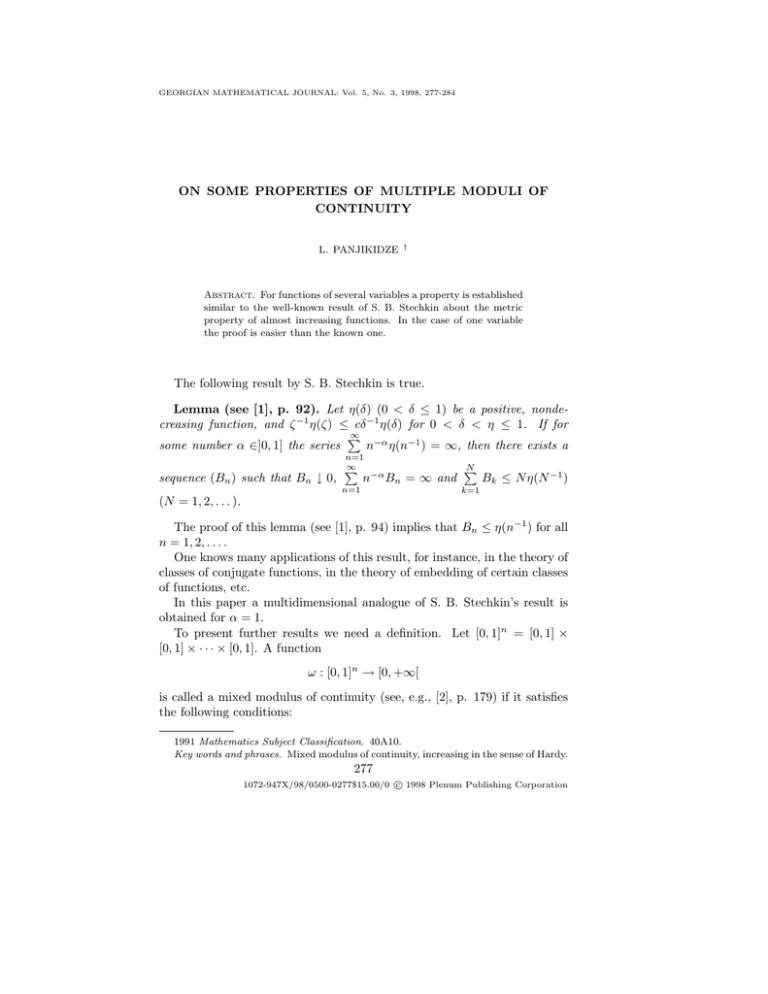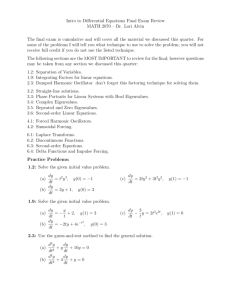ON SOME PROPERTIES OF MULTIPLE MODULI OF CONTINUITY
advertisement

GEORGIAN MATHEMATICAL JOURNAL: Vol. 5, No. 3, 1998, 277-284 ON SOME PROPERTIES OF MULTIPLE MODULI OF CONTINUITY L. PANJIKIDZE † Abstract. For functions of several variables a property is established similar to the well-known result of S. B. Stechkin about the metric property of almost increasing functions. In the case of one variable the proof is easier than the known one. The following result by S. B. Stechkin is true. Lemma (see [1], p. 92). Let η(δ) (0 < δ ≤ 1) be a positive, nondecreasing function, and ζ −1 η(ζ) ≤ cδ −1 η(δ) for 0 < δ < η ≤ 1. If for ∞ P some number α ∈]0, 1] the series n−α η(n−1 ) = ∞, then there exists a n=1 sequence (Bn ) such that Bn ↓ 0, (N = 1, 2, . . . ). ∞ P n=1 n−α Bn = ∞ and N P k=1 Bk ≤ N η(N −1 ) The proof of this lemma (see [1], p. 94) implies that Bn ≤ η(n−1 ) for all n = 1, 2, . . . . One knows many applications of this result, for instance, in the theory of classes of conjugate functions, in the theory of embedding of certain classes of functions, etc. In this paper a multidimensional analogue of S. B. Stechkin’s result is obtained for α = 1. To present further results we need a definition. Let [0, 1]n = [0, 1] × [0, 1] × · · · × [0, 1]. A function ω : [0, 1]n → [0, +∞[ is called a mixed modulus of continuity (see, e.g., [2], p. 179) if it satisfies the following conditions: 1991 Mathematics Subject Classification. 40A10. Key words and phrases. Mixed modulus of continuity, increasing in the sense of Hardy. 277 c 1998 Plenum Publishing Corporation 1072-947X/98/0500-0277$15.00/0 278 L. PANJIKIDZE † (1) ω(0, δ2 , . . . , δn ) = ω(δ1 , 0, . . . , δn ) = · · · = ω(δ1 , δ1 , . . . , 0) = 0 for all 0 ≤ δk ≤ 1, k = 1, 2, . . . , n; (2) ω is continuous on [0, 1]n ; (3) ω does not decrease on [0, 1]n in the sense of Hardy [3]; (4) ω is a semi-additive function with respect to each of the variables. Note that in what follows c will always denote absolute but, generally speaking, different positive constants. Theorem 1. Let the function u : [0, 1]n → [0, +∞[ not decrease with respect to each of the variables, (t0k )−1 u(t1 , . . . , t0k , . . . , tn ) ≥ c(tk00 )−1 u(t1 , . . . , t00k , . . . , tn ) for all 0 < tk0 < t00k ≤ 1, (k = 1, 2, . . . , n, 0 ≤ ti ≤ 1 i = 1, 2, . . . , n, (∗) i 6= k) and Z1 Z1 0 0 ··· Z1 0 (t1 t2 · · · tn )−1 u(t1 , t2 , . . . , tn ) dt1 dt2 · · · dtn = ∞. Then there exists a non-negative function B which does not decrease either with respect to each of the variables and satisfies the conditions: (1) B(t1 , t2 , . . . , tn ) ≤ u(t1 , t2 , . . . , tn ) for all (t1 , t2 , . . . , tn ) ∈ [0, 1]n ; Z1 Z1 Z1 (2) · · · (t1 t2 · · · tn )−1 B(t1 , t2 , . . . , tn ) dt1 dt2 · · · dtn = ∞; 0 (3) 0 0 Z1 Z1 x1 x2 ··· Z1 xn (t1 t2 · · · tn )−2 B(t1 , t2 , . . . , tn ) dt1 dt2 · · · dtn ≤ ≤ c(x1 x2 · · · xn )−1 u(x1 , x2 , . . . , xn ) for all 0 < xk ≤ 1, k = 1, 2, . . . , n. Proof. We set B(t1 , t2 , . . . , tn ) = u(tβ1 , tβ2 , . . . tβn ) for (t1 , t2 , . . . , tn ) ∈ [0, 1]n , where β > 1 is some fixed number. We have Z1 Z1 0 0 ··· Z1 0 (t1 t2 · · · tn )−1 B(t1 , t2 , . . . , tn ) dt1 dt2 · · · dtn = ON SOME PROPERTIES OF MULTIPLE MODULI OF CONTINUITY Z1 Z1 = 0 = β −n 0 =β 0 Z1 Z1 0 −n ··· ··· Z1 Z1 0 Z1 0 Z1 0 ··· 0 279 (t1 t2 · · · tn )−1 u(tβ1 , tβ2 , . . . , tnβ ) dt1 dt2 · · · dtn = (t1 t2 · · · tn )−1/β u(t1 , t2 , . . . , tn ) Z1 0 dt1 dt2 · · · dtn 1 1− 1 1− β 1− 1 t1 t2 β · · · tn β = (t1 t2 · · · tn )−1 u(t1 , t2 , . . . , tn ) dt1 dt2 · · · dtn = ∞, which means that condition (2) is fulfilled. Since (t1 , t2 , . . . , tn ) ∈ [0, 1]n , β > 1, and u does not decrease with respect to each of the variables, we conclude that B does not decrease either with respect to each of the variables, and also B(t1 , t2 , . . . , tn ) ≤ u(t1 , t2 , . . . , tn ) for all (t1 , t2 , . . . , tn ) ∈ [0, 1]n . Therefore condition (1) is fulfilled. Now we will show that relation (3) is true. Let xk be some numbers, 0 < xk < 1 (k = 1, 2, . . . , n). In that case, if I= = Z1 Z1 x1 x2 Z1 Z1 x1 x2 ··· Z1 (t1 t2 · · · tn )−2 B(t1 , t2 , . . . , tn )dt1 dt2 · · · dtn = ··· Z1 (t1 t2 · · · tn )−2 u(t1β , tβ2 , . . . , tβn )dt1 dt2 · · · dtn = xn xn 1/β x1 = Z Z1 ··· Z1 Z1 Z1 ··· Z1 x1 x2 + 1/β x1 x2 xn xn (t1 t2 · · · tn )−2 u(t1β , t2β , . . . , tβn )dt1 dt2 · · · dtn + (t1 t2 · · · tn )−2 u(t1β , tβ2 , . . . , tnβ )dt1 dt2 · · · dtn , then by Fubini’s theorem 1/β x1 I= Z x1 t−2 1 Z1 x2 ··· Z1 xn (t2 · · · tn )−2 u(tβ1 , tβ2 , . . . , tβn ) dt2 · · · dtn dt1 + 280 L. PANJIKIDZE + Z1 t−2 1 Z1 x2 1/β x1 1/β x1 ≤ Z t−2 1 x2 x1 +β Z1 −1 Z1 ··· Z1 xn Z1 −2 τ1 β x1 x2 1/β x1 = Z t1−2 dt1 Z1 + β −1 Z1 x1 Z1 x2 −2 (t2 · · · tn ) ··· Z1 xn ··· x2 x1 (t2 · · · tn )−2 u(tβ1 , t2β , . . . , tβn ) dt2 · · · dtn dt1 ≤ ··· Z1 xn Z1 ··· xn u(x1 , t2 , . . . , tn ) dt2 · · · dtn dt1 + 1 −1 (t2 · · ·tn )−2 u(τ1 , tβ2 , . . . , tnβ )dt2 · · · dtn τ1β dτ1 = (t2 · · · tn )−2 u(x1 , t2β , . . . , tnβ ) dt2 · · · dtn + xn Z1 † 1 − τ1−1 (t2 · · · tn )−2 u(τ1 , t2β , . . . , tβn ) dt2 · · · dtn τ1 β dτ1 . Using the property (∗) of the function u, we obtain Z1 x1 I ≤ [t−1 1 ] 1 x1β +c x1 = x2 (x−1 1 +c x2 Z1 Z1 Z1 − xn ··· −1 x1 β ) x2 ··· 1 1− β ]1x1 + c[τ1 x−1 1 (t2 Z1 x2 x1 ≤ x−1 1 Z1 (t2 · · · tn )−2 u(x1 , tβ2 , . . . , tβn ) dt2 · · · dtn + · · · tn ) xn −1 τ1 β dτ1 Z1 Z1 ··· · Z1 xn ··· x−1 1 Z1 xn Z1 x2 −2 u(x1 , tβ2 , . . . , tβn ) dt2 1 − · · · dtn τ1 β dτ1 = (t2 · · · tn )−2 u(x1 , tβ2 , . . . , tβn ) dt2 · · · dtn + ··· Z1 xn (t2 · · · tn )−2 u(x1 , t2 , . . . , tn ) dt2 · · · dtn ≤ (t2 · · · tn )−2 u(x1 , t2β , . . . , tnβ ) dt2 · · · dtn + · x−1 1 Z1 x2 ··· Z1 xn (t2 · · · tn )−2 u(x1 , tβ2 , . . . , tβn ) dt2 · · · dtn ≤ ON SOME PROPERTIES OF MULTIPLE MODULI OF CONTINUITY ≤ cx−1 1 Z1 ··· Z1 (t2 · · · tn )−2 u(x1 , t2β , . . . , tβn ) dt2 · · · dtn ≡ cI1 , xn x2 281 where Z1 ··· ··· Z1 (t2 · · · tn )−2 u(x1 , tβ2 , . . . , tnβ ) dt2 · · · dtn + ··· Z1 x−1 1 I1 = x2 Z1 xn (t2 · · · tn )−2 u(x1 , tβ2 , . . . , tβn ) dt2 · · · dtn . Next, 1/β x2 I1 = + x1−1 Z Z1 x2 x3 x−1 1 Z1 1/β x2 Z1 x3 xn xn 1/β x2 ≤ x−1 1 + x−1 1 Z x2 1/β x3 −1 x−1 1 (x2 + x−1 1 Z1 1/β x2 + x1−1 1/β x2 xn − x2 ) x3 ··· x3 x3 Z1 x3 xn ··· u(x1 , x2 , t3β , . . . , tβn ) dt3 · · · dtn dt2 + ··· Z1 xn (t3 · · · tn )−2 u(x1 , x2 , tβ3 , . . . , tnβ ) dt3 · · · dtn + (t2 · · · tn )−2 u(x1 , tβ2 , . . . , tβn ) dt2 · · · dtn ≤ xn ··· (t3 · · · tn ) −2 (t2 · · · tn )−2 u(x1 , tβ2 , . . . , tnβ ) dt2 · · · dtn = Z1 Z1 Z1 xn x3 Z1 ··· ··· Z1 xn Z1 Z1 = (x1 x2 )−1 ··· Z1 1 β Z1 ≤ (x1 x1 )−1 Z1 Z1 x3 Z1 Z1 x2 = t−2 2 (t2 · · · tn )−2 u(x1 , tβ2 , . . . , tβn ) dt2 · · · dtn ≤ (t3 · · · tn )−2 u(x1 , x2 , tβ3 , . . . , tβn ) dt3 · · · dtn + (t2 · · · tn )−2 u(x1 , tβ2 , . . . , tβn ) dt2 · · · dtn = Z1 xn (t3 · · · tn )−2 u(x1 , x2 , tβ3 , . . . , tβn ) dt3 · · · dtn + 282 L. PANJIKIDZE + (βx1 ) Z1 −1 ··· = (x1 x2 ) Z1 x3 −1 + (βx1 ) −1 Z1 ··· Z1 xn Z1 x 2 x3 1 t2 β (t2 · · · tn )−2 u(x1 , t2 , tβ3 , . . . , tβn )t2β xn x2 −1 Z1 † ··· −1 dt2 · · · dtn = (t3 · · · tn )−2 u(x1 , x2 , tβ3 , . . . , tβn ) dt3 · · · dtn + Z1 xn 1 −β −2 t−1 u(x1 , t2 , tβ3 , . . . , tβn )t2 2 (t3 · · · tn ) dt2 · · · dtn . Again, using the property (∗) of the function u we have I1 ≤ (x1 x2 )−1 +(x1 β) −1 Z1 x3 ··· xn Z1 Z1 x2 x3 −1 = (x1 x2 ) Z1 x3 Z1 ··· (t3 · · · tn )−2 u(x1 , x2 , t3β , . . . , tβn ) dt3 · · · dtn + Z1 xn ··· Z1 xn 1 β β −β x−1 (t3 · · · tn )−2 dt2 · · ·dtn = 2 u(x1 , x2 , t3 , . . . , tn )t (t3 · · · tn )−2 u(x1 , x2 , tβ3 , . . . , tβn ) dt3 · · · dtn + Z1 1 Z1 Z1 −β −1 t2 dt2 · · · (t3 · · ·tn )−2 u(x1 , x2 , tβ3 , . . . , tβn )dt3 · · ·dtn = +(βx1 x2 ) x2 = (x1 x2 )−1 Z1 x3 + (βx1 x2 ) × Z1 x3 ··· Z1 xn −1 ··· xn (t3 · · · tn )−2 u(x1 , x2 , tβ3 , . . . , tβn ) dt3 · · · dtn + 1 1− β ]1x2 (1 − β −1 )−1 [t2 × (t3 · · · tn )−2 u(x1 , x2 , tβ3 , . . . , tβn ) dt3 · · · dtn ≤ −1 ≤ (x1 x2 ) xn x3 Z1 Z1 x3 ··· Z1 xn (t3 · · · tn )−2 u(x1 , x2 , t3β , . . . , tβn ) dt3 · · · dtn + +(β − 1)−1 (x1 x2 )−1 Z1 x3 ··· Z1 xn (t3 · · ·tn )−2 u(x1 , x2 , t3β , . . . , tnβ )dt3 · · ·dtn = ON SOME PROPERTIES OF MULTIPLE MODULI OF CONTINUITY Z1 Z1 ··· ··· Z1 (t1 · · · tn )−2 B(t1 , t2 , . . . , tn ) dt3 · · · dtn ≤ ≤ c(x1 x2 )−1 Z1 ··· = c(x1 x2 ) −1 x3 xn 283 (t3 · · · tn )−2 u(x1 , x2 , tβ3 , . . . , tnβ ) dt3 · · · dtn . Therefore Z1 x1 xn x3 Z1 xn (t3 · · · tn )−2 u(x1 , x2 , tβ3 , . . . , tnβ ) dt3 · · · dtn . Clearly, continuing a similar reasoning in a step by step manner, we arrive at the inequality Z1 x1 ··· Z1 xn (t1 · · · tn )−2 B(t1 , t2 , . . . , tn ) dt3 · · · dtn ≤ ≤ c(x1 x2 · · · xn )−1 u(x1 , x2 , . . . , xn ) and thus prove the validity of relation (3). Note that by assuming that −1 −1 Bm1 ,m2 ,...,mn = B(m−1 1 , m2 , . . . , m n ) (mk = 1, 2, . . . , k = 1, 2, . . . , n), where B is the function from Theorem 1, we obtain Theorem 2. Let the function u satisfy the conditions of Theorem 1. Then we have a sequence (Bm1 ,...,mn )m1 ≥1,...,mn ≥1 such that Bm1 ,...,mk ,...,mn − Bm1 ,...,mk +1,...,mn ≥ 0 for each mk = 1, 2, . . . (k = 1, 2, . . . , n), N1 N2 X X m1 =1 m2 =1 ··· Nn X mn =1 Bm1 ,m2 ,...,mn ≤ cN1 N2 · · · Nn u(N1−1 , N2−1 , . . . , Nn−1 ) for every Nk = 1, 2, . . . (k = 1, 2, . . . , n), and Bm1 ,m2 ,...,mn ≤ u(m1−1 , m2−1 , . . . , m−1 n ) for every mk = 1, 2, . . . (k = 1, 2, . . . , n). 284 L. PANJIKIDZE † Also note that if u = ω is a mixed modulus of continuity, then the sequence (Bm1 ,...,mn ) will additionally satisfy the condition 1 1 X X k1 =0 k2 =0 ··· 1 X (−1)k1 +k2 +···kn Bm1 +k1 ,m2 +k2 ,...,mn +kn ≥ 0 kn =0 for all mk ≥ 1 (k = 1, 2, . . . , n). Note finally that Theorems 1 and 2 have applications in the theory of embedding of classes of functions of several variables, in the theory of conjugate functions of several variables, and in other problems of multidimensional analysis. References 1. S. B. Stechkin, On the absolute convergence of Fourier series. (Russian) Izv. Akad. Nauk SSSR, Ser. Mat. 17(1953), 87–98. 2. L. V. Zhizhiashvili, Some problems of Fourier trigonometric series and their conjugates. (Russian) Tbilisi University Press, Tbilisi, 1993. 3. G. H. Hardy, On double Fourier series and especially those which represent the double zeta-function with real and incommensurable parameters. Quart. J. Math. 37(1906), No. 1, 53–79. (Received 18.12.1995) Author’s address: Faculty of Mechanics and Mathematics I. Javakhishvili Tbilisi State University 2, University St., Tbilisi 380043 Georgia






